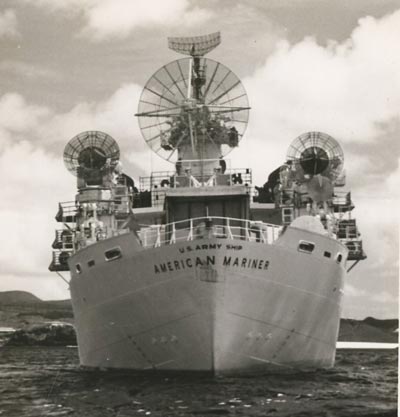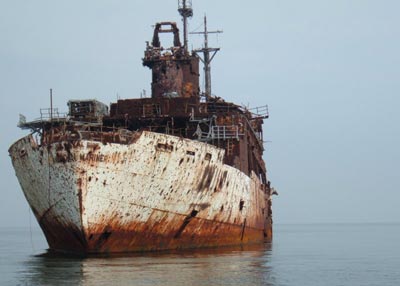Space ghostby Dwayne A. Day
|
| American Mariner was present at the conception of national missile defense—long before there ever was a Strategic Defense Initiative. |
American Mariner was once a member of the United States’ fleet of missile and space tracking ships. Several dozen of these ships have served the missile and space program over the years, although only a couple are in service today, their missions having been assumed by satellites, or negated by changes in procedures and improvements in communications technology and computers. These ships were usually converted troop transports, freighters, oilers, or other auxiliary vessels. American Mariner, however, has one of the more unusual careers and certainly the most unusual fate.
According to Herbert Paul Hahn, who trained aboard her as a merchant marine in the 1940s and later wrote a book about the ship, American Mariner started out her life as a Liberty ship. The Liberties were based upon a British cargo ship design that was purchased by the United States and built in massive numbers—over 2,700 of them by the end of World War 2, making them easily the most mass produced large vessel of all time. When German U-Boats were sinking freighters by the score in the early years of the war, eighteen American shipyards ramped up production and soon were launching Liberty ships faster than the Germans could sink them. They were a prime example of the American war machine that rumbled to life after the Pearl Harbor attack. This impressive construction effort came with a human cost, however: thousands of shipyard workers were exposed to asbestos while assembling their hulls.
She started construction in mid-1941 at Maryland’s Bethlehem-Fairfield shipyard as the cargo ship George Calvert. When the vessel was 65% complete she was converted from a cargo ship to a training ship for merchant marines and renamed American Mariner. She was launched on December 30, 1941 and sent to the nearby Bethlehem Shipbuilding facility at the Key Highway Plant, Baltimore, Maryland. Instead of large cargo holds, she received an extensive superstructure and berthing and other compartments to enable her to take large numbers of merchant marine cadets to sea to prepare them for operating ships—including other Liberty ships—performing convoy duty in the North Atlantic. The superstructure, with its many portholes, gave her the look of a transport ship.
The war machine churned out much more than ships and tanks and planes. It also churned out people—drafting or recruiting them, cramming their heads full of information they needed to do their jobs and (hopefully) stay alive, and then shoving them into the fight. Merchant marines were sent to sea with only a few months, or sometimes only weeks, of training and expected to make do. They occasionally died not because of enemy action, but because of the rush of the war. Several Liberty ships sank because they were overloaded or poorly operated, but for the most part they survived. After the war was over American Mariner continued in service, at a much more leisurely pace than before, and even received a white coat of paint that gave her a certain bit of elegance. By late 1953 she was no longer needed and so she was delivered by tugs to the Hudson River Reserve Fleet at Jones Point, New York. She might have sat there, slowly rusting away, if it was not for the missile age.
| It is safe to say that in the early years of the ballistic missile defense effort the data collected by American Mariner’s sensors formed the basis for developing models of how ballistic missiles appeared during their final stages of reentry. |
Many people tend to think that the concept of shooting down ballistic missiles in flight stems from Ronald Reagan’s Strategic Defense Initiative. However, the idea of shooting down ballistic missiles is nearly as old as ballistic missiles themselves. The first American studies of the possibilities of missile defense were conducted in the mid-1950s and the early conclusion was that it was virtually impossible even with a nuclear-tipped missile—like trying to stop a baseball thrown at your head by tossing firecrackers in the air. But when the US Army started launching longer-range ballistic missiles in the mid-1950s, the Army’s missile leadership also started thinking about how an enemy might shoot them down. They realized that they needed more data, particularly on what an incoming missile reentry vehicle looked like, and so they initiated the Downrange Antimissile Measurement Program, or DAMP. DAMP was run by the Advanced Research Projects Agency, or ARPA, which later went on to fame for developing stealth airplane technology, among other things. Because they were shooting their missiles out over the ocean, the missile reentry vehicles splashed down at sea. And to watch them, the Army needed a ship.
In 1958 the US Army Ordnance Missile Command of the Army Rocket and Guided Missile Agency at Redstone Arsenal in Alabama requested that the Department of Commerce, which owned American Mariner, transfer her to the Army. Her substantial quarters and interior space made her a good choice for the DAMP mission. After five years in mothballs she was covered in rust, but her machinery was still in good condition and in June the ship was towed to the Maryland Shipbuilding and Drydock Company at Baltimore. Over the next seven months she was extensively overhauled and converted. Her quarters were enlarged and air-conditioned. She was given a new coat of white paint. However, most notably, her stern was fitted with a large array of sensors.
 American Mariner was equipped with three large radar dishes and numerous optical tracking sensors for analyzing the characteristics of ballistic missile reentry vehicles beginning in the late 1950s. (credit: Ted Bojanowski) |
The most noticeable change was the addition of three large radar dishes. Two 16-foot (4.9-meter) dish antennas supporting FPQ-4 radars were fitted on either side of her aft superstructure. But the most prominent new feature was a 28-foot (8.5-meter) diameter dish (later expanded to 30 feet (9.1 meters)) supporting an L-band radar mounted high on her superstructure immediately aft of her funnel—a position that was certainly not ideal considering that exhaust gasses would blow on the dish. Scattered around her aft decks were numerous pedestals and mounts for infrared, visible light, and other tracking telescopes and sensors. Many of these were directly slaved to the radars so that whatever they were tracking would be squarely in the crosshairs of the optical sensors. The ship was also fitted with photo labs for developing the film from the various sensors and cameras.
In early 1959 American Mariner put to sea for the first time in many years, heading down to Cape Canaveral with “U.S. Army Ship” painted on her stern above her name and manned by a civilian contractor crew with government and private engineers and scientists operating her advanced equipment. After checkout she sailed out into the Atlantic Ocean to observe the streaks of reentry vehicles screaming back into the atmosphere, and during her first year in service she monitored fourteen missile launches. In early 1961 her large radar dish was upgraded with the addition of a powerful new dual-frequency radar. Much of this work remains classified to this day, but it is safe to say that in the early years of the ballistic missile defense effort the data collected by American Mariner’s sensors formed the basis for developing models of how ballistic missiles appeared during their final stages of reentry.
The ship’s ownership was eventually turned over to the US Air Force, although she was still operated by contractors. In late 1962 American Mariner sailed into the Pacific for a different kind of classified mission. This time she was deployed to monitor Operation FISHBOWL. FISHBOWL involved the detonation of nuclear weapons at high altitude—just below space or high above the last fringes of the Earth’s atmosphere. These nuclear weapons tests were intended to determine if a nuclear explosion could knock an incoming missile out of the sky. Thus, while still serving in the anti-missile research role, American Mariner was now monitoring the defending as opposed to the attacking weapons.
| Surprisingly, even after forty years of abuse by weather and weapon, she remains substantially intact, startling boaters on the bay who come across her today. |
After FISHBOWL ended, the ship was detailed to NASA to support manned spaceflight operations, including tracking the reentry of Mercury spacecraft. For the next several years she was available to NASA, but the military had less and less need for her. By the mid-1960s American Mariner was superfluous. Two of her tracking dishes were removed, although the large one remained. In October 1966 she was taken to a spot in Chesapeake Bay and a Navy Underwater Demolition Team from Norfolk used explosives to punch holes in her side and flood her, so that she settled gently into the Maryland mud.
American Mariner’s new role was to serve as a target ship for pilots from the US Naval Air Station at Patuxent River, Maryland. Over the next two decades the ship was attacked by helicopters and aircraft flying out of Pax River, primarily serving as a gunnery target. Occasionally inert missiles and bombs were fired at her and over time her hull became pockmarked. But surprisingly, even after forty years of abuse by weather and weapon, she remains substantially intact, startling boaters on the bay who come across her today. Her role in the space and missile program was never a large one, and the results of her missile defense research work remain largely classified, but she still refuses to fade completely away.
